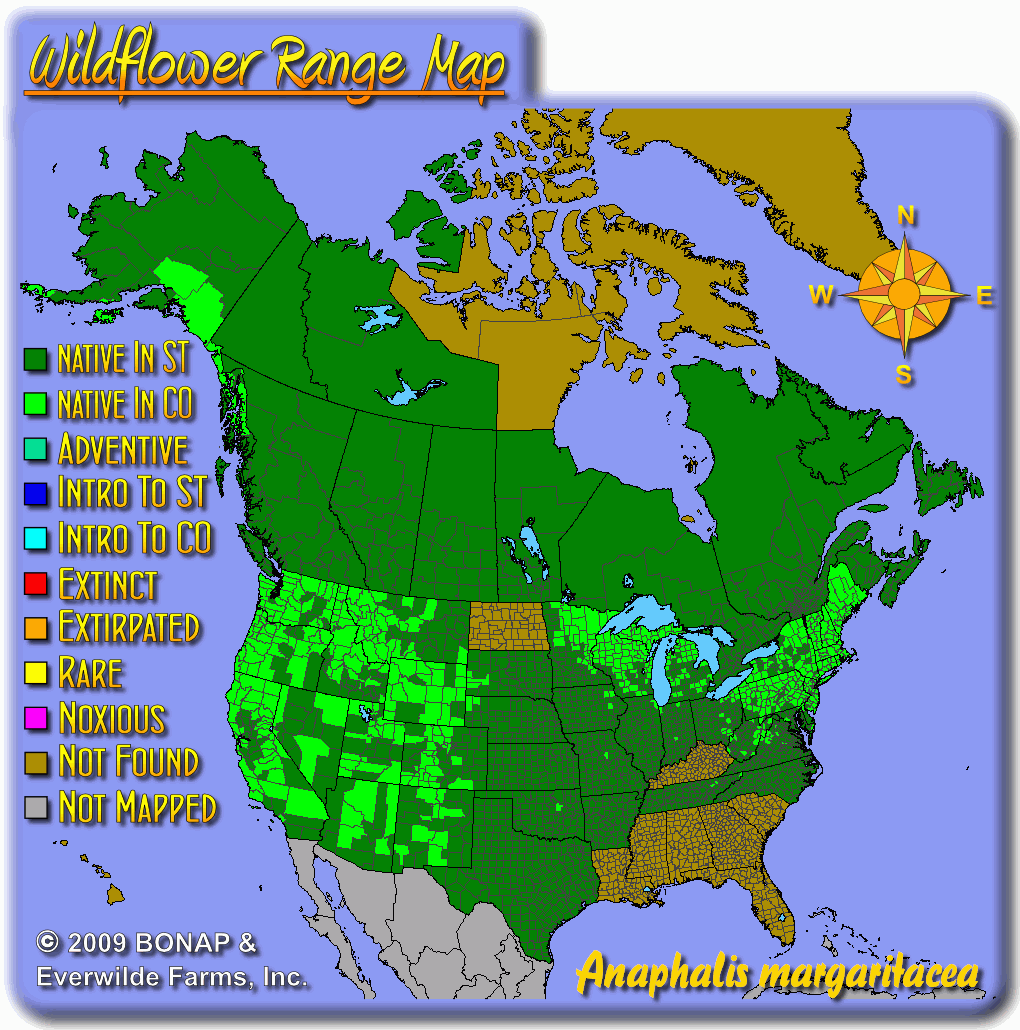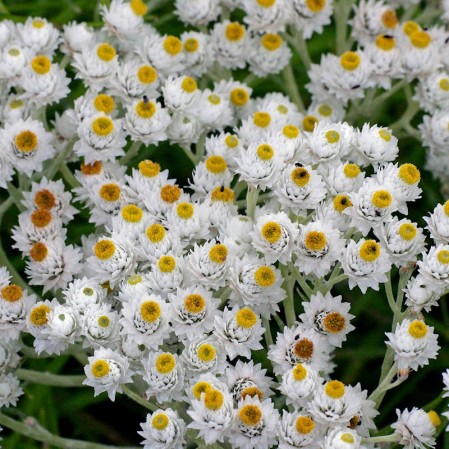Pearly Everlasting Seeds
- HOW TO GROW
- FAST FACTS
- REVIEWS
HOW TO GROW
Sowing: The easiest way to grow this plant is to direct sow in the fall, sowing the tiny seed as thinly as possible on the surface of the soil. It may be necessary to thin the seedlings to 18-24" apart or transplant some of the seedlings to allow room for growth. To start Pearly Everlasting seeds indoors, sow the seed on the surface of the soil; it usually germinates in 4-6 weeks at 60-65 degrees F. When the seedlings grow tall enough to handle safely and there is no chance of frost, transplant them.
Growing: Though this plant tolerates drought, it should be watered for best growth and appearance. This plant grows best in full sun and rich, well drained soil. It also adapts to moist soil with adequate drainage. Do not over water, since soil with excessive moisture may cause disease. Since this plant reseeds itself readily, deadhead the faded flowers if volunteer plants are not wanted. After several years' growth, pearly everlasting can be divided for new plantings.This plant is deer and rabbit resistant, as well as attracting bees and butterflies; the caterpillars of the American Lady butterfly use pearly everlasting as a host plant.
Harvesting: Pearly Everlasting is renowned for its excellent dried flowers. To dry them, cut the stems before the blossoms fully open; hang them upside down in a dark place until dry. This plant can also be used for fresh cut flowers.
Seed Saving: Both male and female plants must be present for the plant to produce viable seed. When the centers of the flowers turn dark brown, Pearly Everlasting seeds are mature. Remove the heads and spread them out to dry away from direct sunlight. Thresh the heads to separate the seed material from the papery husk. Store Pearly Everlasting seeds in a cool, dry place.
FAST FACTS
Common Names: Western Pearly-everlasting
Latin Name: Anaphalis margaritacea
Species Origin: US Native Wildflower
Type: Native Wildflowers
Life Cycle: Perennial
USDA Zones: 1, 2, 3, 4, 5, 6, 7, 8, 9, 10
US Regions: California, Mountain, Arid/Desert, Plains/Texas, Midwest, Northern, Northeast
Seeds per Ounce: 222,000
Stratification: No Stratification
Germination Ease: No Stratification
Sunlight: Full Sun, Part Sun
Height: 20 Inches
Color: White
Bloom Season: Blooms Late Summer, Blooms Early Fall
Uses: Dried Flowers
Super!
I love the mylar packaging and the detailed instructions. Also the artwork and esthetics are the best of all the seed companies.
DESCRIPTION

HOW TO GROW
Sowing: The easiest way to grow this plant is to direct sow in the fall, sowing the tiny seed as thinly as possible on the surface of the soil. It may be necessary to thin the seedlings to 18-24" apart or transplant some of the seedlings to allow room for growth. To start Pearly Everlasting seeds indoors, sow the seed on the surface of the soil; it usually germinates in 4-6 weeks at 60-65 degrees F. When the seedlings grow tall enough to handle safely and there is no chance of frost, transplant them.
Growing: Though this plant tolerates drought, it should be watered for best growth and appearance. This plant grows best in full sun and rich, well drained soil. It also adapts to moist soil with adequate drainage. Do not over water, since soil with excessive moisture may cause disease. Since this plant reseeds itself readily, deadhead the faded flowers if volunteer plants are not wanted. After several years' growth, pearly everlasting can be divided for new plantings.This plant is deer and rabbit resistant, as well as attracting bees and butterflies; the caterpillars of the American Lady butterfly use pearly everlasting as a host plant.
Harvesting: Pearly Everlasting is renowned for its excellent dried flowers. To dry them, cut the stems before the blossoms fully open; hang them upside down in a dark place until dry. This plant can also be used for fresh cut flowers.
Seed Saving: Both male and female plants must be present for the plant to produce viable seed. When the centers of the flowers turn dark brown, Pearly Everlasting seeds are mature. Remove the heads and spread them out to dry away from direct sunlight. Thresh the heads to separate the seed material from the papery husk. Store Pearly Everlasting seeds in a cool, dry place.
FAST FACTS
Common Names: Western Pearly-everlasting
Latin Name: Anaphalis margaritacea
Species Origin: US Native Wildflower
Type: Native Wildflowers
Life Cycle: Perennial
USDA Zones: 1, 2, 3, 4, 5, 6, 7, 8, 9, 10
US Regions: California, Mountain, Arid/Desert, Plains/Texas, Midwest, Northern, Northeast
Seeds per Ounce: 222,000
Stratification: No Stratification
Germination Ease: No Stratification
Sunlight: Full Sun, Part Sun
Height: 20 Inches
Color: White
Bloom Season: Blooms Late Summer, Blooms Early Fall
Uses: Dried Flowers
Reviews
Review
Super!
I love the mylar packaging and the detailed instructions. Also the artwork and esthetics are the best of all the seed companies.





